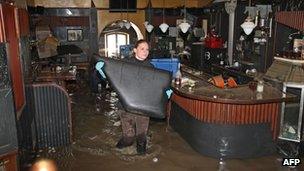German floods: Counting the cost and laying blame
- Published

As the floods recede, the people of Passau can assess the damage
As the waters retreat, what's left is not pleasant: a mountain of mud - and awkward questions over cost and blame.
In Passau in southern Germany, where the Danube rose to levels not seen for 500 years, local people are looking at the sodden ruins of their ground floor shops and homes, and wondering who will pick up the bill for the damage.
The area was prone to floods, and local people grew to expect a serious one every four years or so. Insurance companies became reluctant to offer policies covering against loss (or to charge prohibitively high premiums to cover the heightened risk).
So many people went without. One shopkeeper said: "My existence has been destroyed overnight - destroyed." Another resident said: "We do not have insurance. There is no possibility for insurance. You can't insure a home in a flood area".
And he's right. The chief executive of the insurance giant Munich Re, Nikolaus von Bomhard, said there seems to be a lot of under-insurance in the flood-affected areas. As he put it: "The macroeconomic loss will be much bigger than the insured loss".
The industry is likely to face many claims from car owners. Cars, unlike houses and the property therein, do get insured.
One of the problems for the industry is that so many rivers have been affected simultaneously, from the Danube in southern Germany and Austria, up to the Elbe, which runs into the North Sea. The area of damage is wide and populous.
Prevention and preparation
But the view of some in the insurance industry is that it could have been worse.

Locals are wondering who will pay for the damage
After the big floods of 2002, much engineering work was done on flood prevention.
"Many people are making parallels to 2002, but we are not seeing the same scale of damages," said Clement Booth of Allianz, Europe's biggest insurer.
Even though the 2002 flood prodded people and governments into improving flood defences, there is now a political row over why even more was not done.
The leader of Bavaria, Horst Seehofer, said that he wanted to speed up planning procedures for flood defences.
He felt that it was too easy to stall a project. He cited farmers who were reluctant to sell their land so that flood defences could be built.
He told the newspaper Die Welt that his government would examine whether existing law was tough enough to compel property owners to act in the public interest.
There has, though, been a lot of debate and argument over plans for the development of the Danube, which is a major commercial waterway, taking barges through the heart of Europe.
Mr Seehofer conceded that the assessment of exactly how that big project should proceed might have put a brake on flood-prevention work. "We didn't want to spend money twice", he said.
Delays and recriminations
The construction industry had a different take, though. Its spokesman said that residents in endangered areas had opposed flood-prevention schemes.
"There are many structural solutions on offer which can prevent flooding catastrophes, but they simply haven't proceeded," said Thomas Bauer, the president of the Federation of the German Construction Industry.

The Danube rose to levels not seen for 500 years
The industry says that in Saxony in Eastern Germany alone, there were 350 projects planned after the flood of 2002 but only 80 had been completed.
They may reflect on that in the town of Grimma. The old town was devastated in the floods of 2002 and the authorities resolved to build a flood protection wall with gates to let water in and out.
It would have cost 40 million euros and been financed partly by the European Union.
But there were protests - flood protection walls are not the most beautiful structures.
Protesters went to court, so the start of the project was postponed until 2007, with an estimated completion by 2017. The result is that Grimma - bereft of the protection of the planned wall - has been hit again.
One paper put a headline over the story of Grimma: "The flood comes four years too early".
- Published6 June 2013
- Published5 June 2013
- Published4 June 2013
- Published4 June 2013
- Published3 June 2013